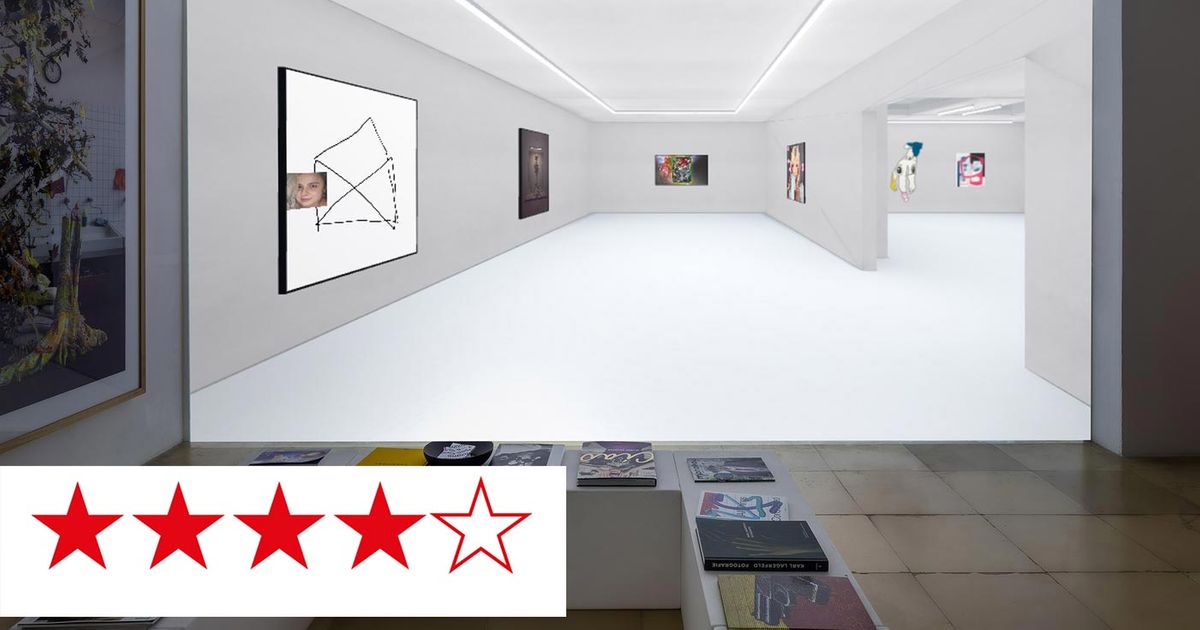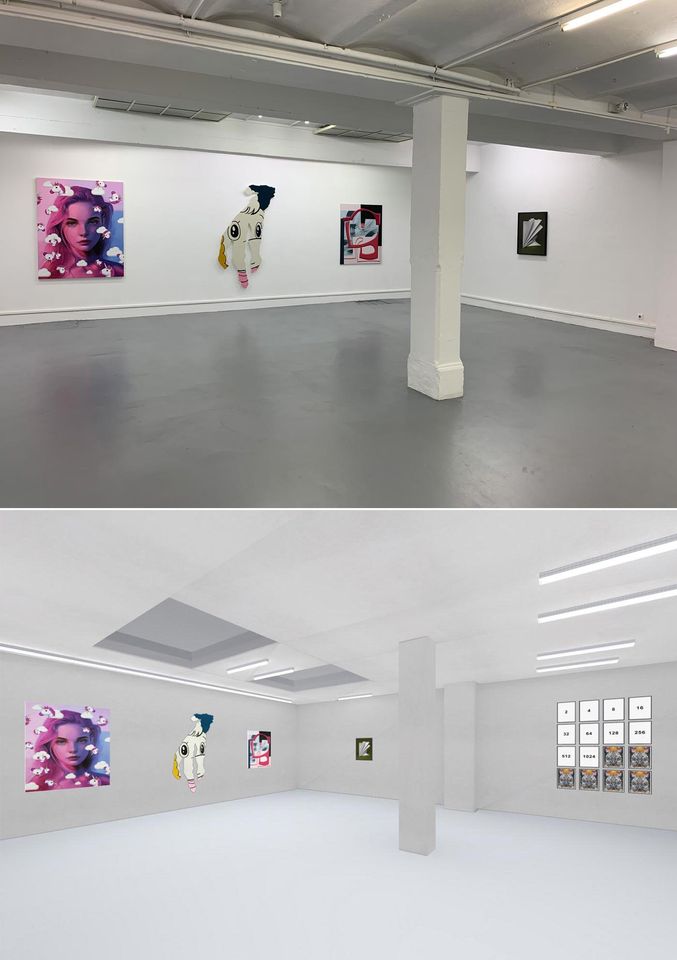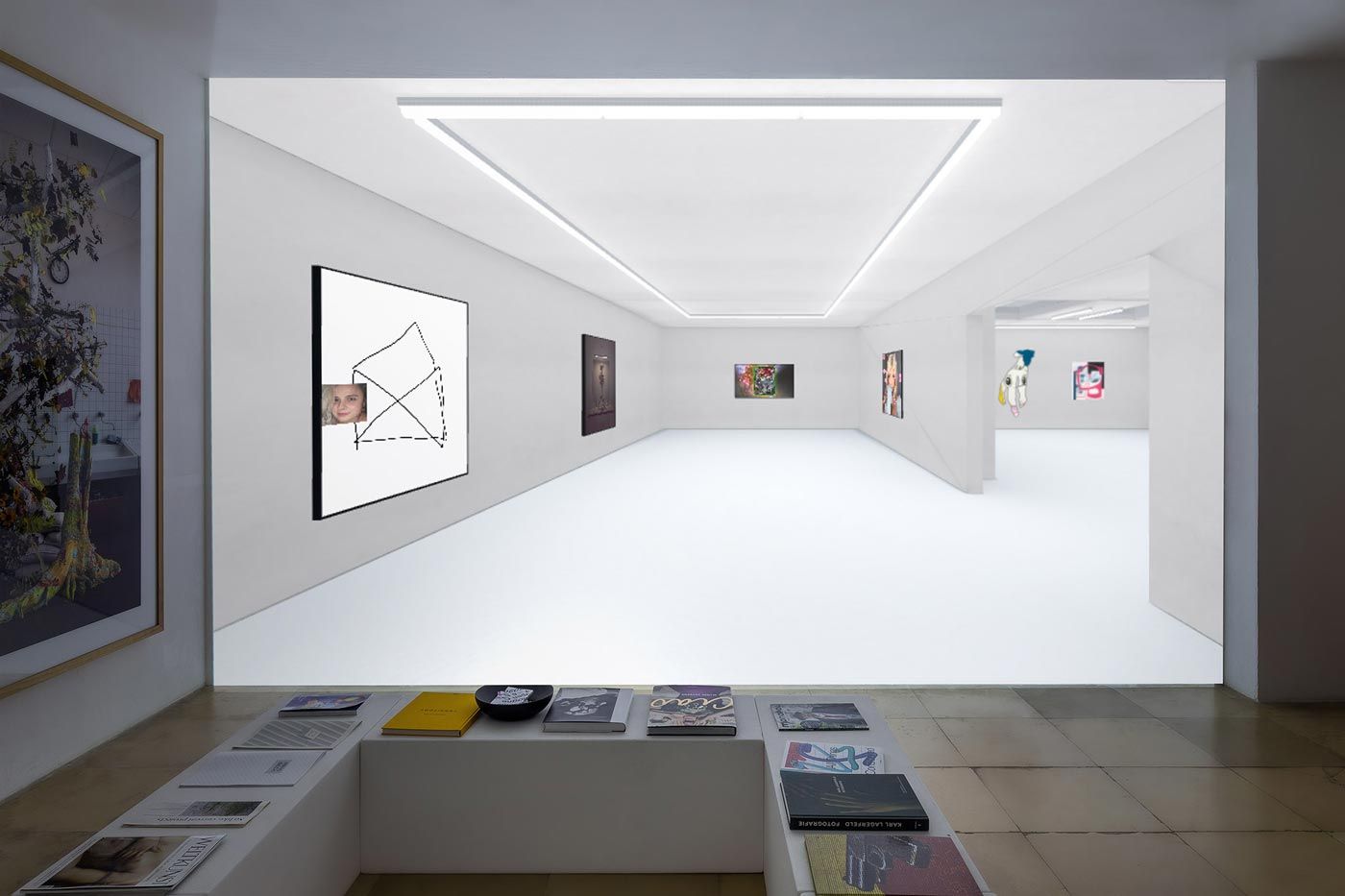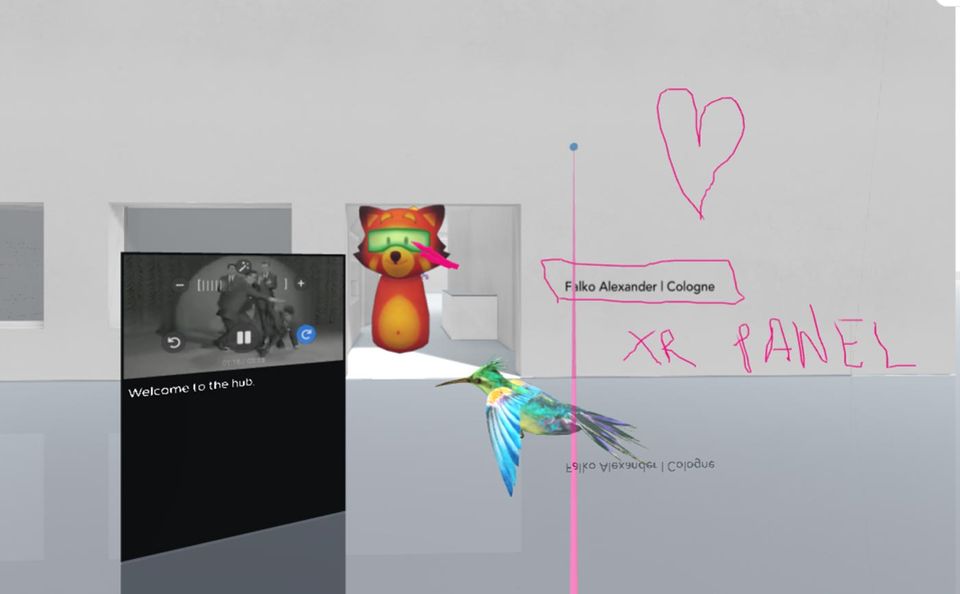The Art Newspaper’s XR Panel
What exactly is extended reality (XR) and how is it being used in art? We bring together an international group of experts in the field to review and make sense of the cutting-edge, digital work that artists, museums, galleries and app-makers are creating across the spectrum of XR—from augmented to virtual reality.
Each XR review gives an overview of a project and a statement from the creators before our expert panel rate it based on ease of use, how good the art is, the medium-specific qualities it employs and whether it breaks new ground. Read all our XR reviews here.
 Interleaving—IRL vs VR
Interleaving—IRL vs VR
The group show Interleaving—IRL vs VR marks a first step into the virtual realm for the Falko Alexander Gallery, in Cologne. In preparation, the gallery’s two rooms were recreated as digital copies in the 3D design software SketchUp, then extended by creating a further exhibition space that exists exclusively in the virtual. The experience was subsequently implemented in the virtual sharing platform Mozilla Hubs. In addition, three new digital floors, which are copies of the rooms on the gallery’s ground floor, were added. Though still empty, these new floors can already be accessed via a virtual spiral staircase. In the future, digital versions of the shows will move up one floor at a time once they have ended.
The virtual rooms will thus become temporary archives in which past exhibitions can still be viewed digitally for some time after the In Real Life (IRL) exhibition has closed.
Created by: Falko Alexander Gallery running on Mozilla Hubs
Where to find itOn Mozilla Hubs web page At Falko Alexander Gallery, Venloer Str. 24, 50672 Köln, until 28 August 2021Curator’s note
Interleaving uses technology aspirationally, as a tool of literal (if virtual) expansion and visualisation GRETCHEN ANDREW
I have this recurring dream where I discover there’s a room in my house that I’ve not known about before. It has always left me with a feeling of positive possibility. This is why I’m excited to have selected Interleaving by the Falko Alexander Gallery for consideration by this panel. We’ve reviewed experiences that treat VR more like a medium and many that treat it primarily as a distribution platform. What is interesting to me about Interleaving is that, by using VR to add additional rooms to a physical space, it does both. Interleaving uses technology aspirationally, as a tool of literal (if virtual) expansion and visualisation.
Subtitled “IRL vs VR”—In Real Life vs virtual reality—in the press release, it is more an exhibition of “ands”. IRL and VR: virtually replicated space and that which is not physically possible. Expanding beyond the gallery’s physical walls, Interleaving has the joy of creation. It is successfully reflective of many of the practices in the group show, including that of Chris Drange whose work brings the aspirational reality of social media representation back into the physical world as a sort of waking dream.
Gretchen Andrew, Curator of the XR panel
They say:
The exhibition architecture is designed in such a way that an interleaving between real and virtual spaces takes place Falko Alexander Gallery
Interleaving combines a real existing group exhibition in the rooms of Falko Alexander Gallery with a VR exhibition that will take place on the digital platform Mozilla Hubs. The exhibition architecture is designed in such a way that an interleaving between real and virtual spaces takes place.
The non-existent exhibition space is made visible in the gallery with projections and screens. With the help of VR glasses, visitors can walk through the wall to the non-existent space within the exhibition and enter the digital space.
 We say:
We say:
For an emerging gallery, the exhibition is a promising step into the virtual world Jürgen Dehm
Jürgen Dehm: Interleaving presents both physical as well as purely digital artworks (NFTs) by Arno Beck, Chris Drange, Anna Nero, Matthias Danberg, Florian Kuhlmann, Michael Reisch, Götz Schramm and Marta Vovk. There are the gallery’s artists or artists with whom a close co-operation is planned in the future. In the physical exhibition space, all participating artists except Matthias Danberg show analogue wall pieces that reference and reflect the digital sphere. Of the four works in the virtual space, three—by Marta Vovk, Chris Drange, and Michael Reinsch—are new. Compared to those in IRL, the three digital works as well as the video Pictures_1080 (2016) by Matthias Danberg, which is also shown in the virtual exhibition space, stand out as featuring—sometimes minimal—movements.
An on-site visit guarantees an optimal experience. At the gallery, the materiality and textuality of the analogue works—for example, the difference between the oil painting by Götz Schramm and the varnish-covered work by Marta Vovk—is evident in contrast to their digital doppelgängers. At the gallery, the access to the virtual version of the exhibition is enabled through an Oculus Quest 2 VR headset. This is the best way to understand the movements that feature in all of the digital works; if the exhibition is accessed via a phone or computer its functionality depends on the capabilities of the respective device.
Apart from the exhibition’s wall text—which is missing in the physical space in Cologne—the digital version does not contain any labels or written information. This makes it difficult to assign the works to the individual artists or learn more about them. Sales platforms such as Artsy or one for NFTs would offer the opportunity to provide further details of the individual works, but in the virtual space there was no link redirecting to such platforms.

For the Falko Alexander Gallery, Interleaving highlights the potential of interweaving real space and virtual space. Already a big screen on the physical gallery’s wall serves—in a way—as a window into the new virtual world and thus supports the concept of combined, rather than opposed, spaces. Attractive (albeit a little creepy) is the possibility of talking to digital visitors on Mozilla Hubs via microphone and speakers from the real gallery, and vice versa. As I was the only visitor of the exhibition during my test run, I am not able to verify this feature’s full functionality.
For an emerging gallery, the exhibition is a promising step into the virtual world. In the future, after the beta phase, one would hope that media-specific artworks will be presented more boldly or that artists will take a more critical approach to create projects that combine IRL and VR. Particular attention should also be paid to the opportunity to provide information on artists and artworks. However, the “archiving” of older exhibitions on the higher, digital floors of the gallery is an innovative project and an added bonus.
Is it accessible?
The medium democratises VR and makes it accessible to all equipped with a compatible web browser Carole Chainon

Carole Chainon: This is our first review of a Mozilla Hubs exhibit! I have been very fond of Mozilla Hubs since its launch. Users can create a 3D world of their choice and others can join in. The medium democratises VR and makes it accessible to all equipped with a compatible web browser. I used Mozilla on a computer and the navigation was very smooth using the WASD keys and my mouse.
Dhiren Dasu: The app loaded on my Android phone and was easily navigable, although a tad glitchy at times. I did find myself having to refresh and re-enter the VR space due to the page timing out. A map would be helpful. Overall it was a positive user experience.
Jürgen Dehm: Only an on-site visit to the Cologne gallery—where an Oculus Quest 2 VR headset is provided—offers an optimal experience of both the show and the artworks. With my iPhone XS, the virtual exhibition could be explored without any major problems.
Jasper Spires: The gallery was easily accessible online, hovering on the void of a white plain as it was. Aside from those still developing their tech-literacy, I can’t imagine there being significant difficulties in exploring the space.
From a critical, art historical standpoint, how good is the art?
This show raises interesting questions in terms of where art lives, how we can view it, own it, share it and store it dhiren dasu
Carole Chainon: The works exhibited are a mix of “real” artworks that have been digitised and digital artworks sold as NFTs—a great way to introduce this form of digital art to new audiences. These are still the early days of NFTs and the experience showcases their potential and how they could evolve in the next decade. Public awareness of, and reception to, digital works has increasingly warmed as they become more ubiquitous, including the use of AR face filters. One such work in this experience makes use of a face filter with the unicorn emoji and a collage of early video games characters against the milky way, in an oneiric and electronic portrayal of our times.
Dhiren Dasu: I really liked quite a few of the works—some for the execution, others for the conceptual questions they pose. I thought the NFT auction link on the (physical) gallery walls is a sign of things to come for all gallery shows in the future—be they IRL or VR. This show raises interesting questions in terms of where art lives, how we can view it, own it, share it and store it. All questions that digital art and the NFT space in particular address in novel ways.
Jürgen Dehm: Some of the IRL works, such as the oil painting by Götz Schramm or the conceptual print series by Florian Kuhlmann, offer interesting reflections on the digital in analogue media. One would have hoped for more challenging works in virtual space, but as this is the gallery’s first virtual exhibition there is still room for development in the future.
Jasper Spires: Overlapped with the virtuality of the exhibition, the NFT works featured likewise skirt the liminal boundary between the previously exclusionary gallery spaces and the democratic plateau of online art curation.
What medium-specific qualities of VR/AR does it employ?
Though the upper floors of Falko Alexander’s simulation may await future work, the sense of exploration among the art has a utopian quality to it jasper spires
Carole Chainon: Accessibility and the feeling of immersion are among the most important qualities in VR and they are both present here. It would have been good to see the space more “furnished”. In Mozilla Hubs, there is the possibility to draw and add 3D objects or avatars so it was fun to personalise the space. The social aspect is always a plus in VR and helps to engage the audience.
Dhiren Dasu: Given that portions of this show are only accessible in VR/AR, I thought this was a good rendition of the overlap that IRL and VR shows can share. Allowing visitors to the physical gallery to don goggles and walk through a virtual window is exactly what the medium is designed to do. The show successfully demonstrates how seamless travelling between the real and virtual world can be.
Jürgen Dehm: The digital version of the exhibition is a nice teaser and makes you want to see the original analogue works. Both the digital recreation of the gallery and its extension are interesting ideas, but not ground-breaking anymore.
Jasper Spires: Though the upper floors of Falko Alexander’s simulation may await future work, the sense of exploration amongst the art has a utopian quality to it. It feels as if I am exploring the curator’s bedroom or some other place for private collections.
![]() Does it break new ground technically?
Does it break new ground technically?
The crossover from IRL to VR is groundbreaking and opens the door to art that can transcend locality and physicality dhiren dasu
Carole Chainon: Mozilla Hubs has been around for a few years but it is great to see it used efficiently here and with NFTs. There is also a social aspect and personalisation that make the experience more appealing.
Dhiren Dasu: The crossover from IRL to VR is groundbreaking and opens up the door to art that can transcend locality and physicality. I do look forward to more implementations of this sort. I suspect this multi-pronged approach to gallery shows will be de facto in the very near future.
Jürgen Dehm: The plan to “digitally archive” older exhibitions—to move them to the new, virtual floors of the gallery—is certainly an inventive approach.
Jasper Spires: The interplay between the real space at Falko Alexander and its virtual extensions provides an effective representation of how NFT art and cyberspace in general affects the experience of an exhibition; drawing attention to the phantasmic digital supplements that are now more or less required when displaying work.
What does it say to you about the future of the medium/art form/use of XR within the art world?
The exhibition provides the opportunity for a Piranesian gallery experience, at present unavailable in the physical world jasper spires
Dhiren Dasu: I expect that many art venues will take this hybrid approach to reach more viewers as well as transcend the limitations of physical display space.
Jasper Spires: Participating in the accelerating incorporation of XR tech into the presentation of works, the exhibition provides the opportunity for a Piranesian gallery experience, at present unavailable in the physical world. It serves as a prototype for potentially boundless architecture and artworks in any number of digital rooms, one thousand floors higher than any concrete space.
The XR panel’s ratings
Gretchen Andrew gave a rating of 4/5 stars
Dhiren Dasu gave a rating of 4/5 stars
Carole Chainon gave a rating of 3/5 stars
Jürgen Dehm gave a rating of 3/5 stars
Jasper Spires gave a rating of 4/5 stars
Giving an overall panel rating of 4/5 stars
The Art Newspaper’s XR Panel
Gretchen Andrew is a Search Engine Artist and Internet Imperialist who hacks powerful systems with art, code and glitter. You can see her current VR exhibition on Artland.
Carole Chainon is the co-founder of JYC, an XR development and production studio based in LA with a presence in Europe, creating XR experiences for the entertainment and enterprise sector. She is also a Spark AR Creator.
Dhiren Dasu is a digital media creator and consultant. His areas of speciality include photography, film, virtual space, graphic design, visual effects, animation, and audio production. Dasu, in his fine art persona as Shapeshifter7, makes artworks that echo and recompose the architectural spaces he photographs, turning them into immersive spaces while exploring the nexus of photography, collage, symbols, and perception.
Jürgen Dehm is a writer and curator of modern and contemporary art with a focus on the intersections of visual art and moving image practices.
Jasper Spires is a philosophy and arts writer, whose work focuses on the phenomenological mechanisms present in both abstract philosophical texts and contemporary visual culture. His writing can be found in The Spectator, FAD Magazine and Port Magazine.
Source link : https://www.theartnewspaper.com/review/interleaving-vr-exhibition












